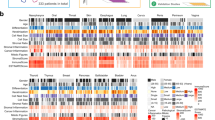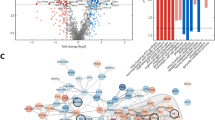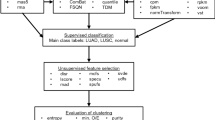Abstract
Background
Lung adenocarcinoma (LUAD) is a predominant subtype of lung cancer. Although molecular classification of LUAD has been widely explored, proteomics-based subtyping of LUAD remains scarce.
Methods
We proposed a subtyping method for LUAD based on the expression profiles of 500 proteins with the largest expression variability across LUAD. Furthermore, we comprehensively compared molecular and clinical features among the LUAD subtypes.
Results
Consensus clustering identified three subtypes of LUAD, namely MtE, DrE, and StE. We demonstrated this subtyping method to be reproducible by analyzing two independent LUAD cohorts. MtE was characterized by high enrichment of metabolic pathways, high EGFR mutation rate, low stemness, proliferation, invasion, metastasis and inflammation signatures, favorable prognosis; DrE was characterized by high enrichment of DNA repair pathways, high TP53 mutation rate, and high levels of genomic instability, stemness, proliferation, and intratumor heterogeneity (ITH); and StE was characterized by high enrichment of stroma-related pathways, high KRAS mutation rate, and low levels of genomic instability.
Conclusions
The proteomics-based clustering analysis identified three LUAD subtypes with significantly different molecular and clinical properties. The novel subtyping method offers new perspectives on the cancer biology and holds promise in improving the clinical management of LUAD.






Similar content being viewed by others
Data availability
Publicly available datasets were analyzed in this study. The CPTAC-LUAD data can be found at: (https://www.linkedomics.org/data_download/CPTAC-LUAD/), and the LUAD-Xu data were from a related publication [13].
References
Huang J, Deng Y, Tin MS, Lok V, Ngai CH, Zhang L, et al. Distribution, risk factors, and temporal trends for lung cancer incidence and mortality: a global analysis. Chest. 2022;161(4):1101–11.https://doi.org/10.1016/j.chest.2021.12.655
Xia C, Dong X, Li H, Cao M, Sun D, He S, et al. Cancer statistics in China and United States, 2022: profiles, trends, and determinants. Chin Med J. 2022;135(05):584–90.https://doi.org/10.1097/CM9.0000000000002108
Chen Z, Fillmore CM, Hammerman PS, Kim CF, Wong K-K. Non-small-cell lung cancers: a heterogeneous set of diseases. Nat Rev Cancer. 2014;14(8):535–46.https://doi.org/10.1038/nrc3775
Tavernari D, Battistello E, Dheilly E, Petruzzella AS, Mina M, Sordet-Dessimoz J, et al. Nongenetic evolution drives lung adenocarcinoma spatial heterogeneity and progressionnongenetic evolution of lung adenocarcinoma heterogeneity. Cancer Discov. 2021;11(6):1490–507.https://doi.org/10.1158/2159-8290.CD-20-1274
Li WY, Zhao TT, Xu HM, Wang ZN, Xu YY, Han Y, et al. The role of EGFR mutation as a prognostic factor in survival after diagnosis of brain metastasis in non-small cell lung cancer: a systematic review and meta-analysis. BMC Cancer. 2019;19(1):145.https://doi.org/10.1186/s12885-019-5331-z
Network CGAR. Comprehensive molecular profiling of lung adenocarcinoma. Nature. 2014;511(7511):543.https://doi.org/10.1038/nature13385
Gillette MA, Satpathy S, Cao S, Dhanasekaran SM, Vasaikar SV, Krug K, et al. Proteogenomic characterization reveals therapeutic vulnerabilities in lung adenocarcinoma. Cell. 2020;182(1):200–25.https://doi.org/10.1016/j.cell.2020.06.013
Liu Q, Lei J, Zhang X, Wang X. Classification of lung adenocarcinoma based on stemness scores in bulk and single cell transcriptomes. Comput Struct Biotechnol J. 2022;20:1691–701.https://doi.org/10.1016/j.csbj.2022.04.004
Menyhárt O, Győrffy B. Multi-omics approaches in cancer research with applications in tumor subtyping, prognosis, and diagnosis. Comput Struct Biotechnol J. 2021;19:949–60.https://doi.org/10.1016/j.csbj.2021.01.009
Yaffe MB. Why geneticists stole cancer research even though cancer is primarily a signaling disease. Sci Signal. 2019. https://doi.org/10.1126/scisignal.aaw3483.
Macklin A, Khan S, Kislinger T. Recent advances in mass spectrometry based clinical proteomics: applications to cancer research. Clin Proteomics. 2020;17:17.https://doi.org/10.1186/s12014-020-09283-w
Gry M, Rimini R, Strömberg S, Asplund A, Pontén F, Uhlén M, et al. Correlations between RNA and protein expression profiles in 23 human cell lines. BMC Genomics. 2009;10(1):1–14.https://doi.org/10.1186/1471-2164-10-365
Xu J-Y, Zhang C, Wang X, Zhai L, Ma Y, Mao Y, et al. Integrative proteomic characterization of human lung adenocarcinoma. Cell. 2020;182(1):245–61.https://doi.org/10.1016/j.cell.2020.05.043
Hanzelmann S, Castelo R, Guinney J. GSVA: gene set variation analysis for microarray and RNA-seq data. BMC Bioinformatics. 2013;14:7.https://doi.org/10.1186/1471-2105-14-7
Langfelder P, Horvath S. WGCNA: an R package for weighted correlation network analysis. BMC Bioinform. 2008;9(1):1–13.https://doi.org/10.1186/1471-2105-9-559
Bland JM, Altman DG. Survival probabilities (the Kaplan-Meier method). BMJ. 1998;317(7172):1572.https://doi.org/10.1136/bmj.317.7172.1572
Li M, Zhang Z, Li L, Wang X. An algorithm to quantify intratumor heterogeneity based on alterations of gene expression profiles. Commun Biol. 2020;3(1):505.https://doi.org/10.1038/s42003-020-01230-7
Benjamini Y, Hochberg Y. Controlling the false discovery rate: a practical and powerful approach to multiple testing. J Roy Stat Soc. 1995;57(1):289–300.https://doi.org/10.1111/j.2517-6161.1995.tb02031.x
Raudvere U, Kolberg L, Kuzmin I, Arak T, Adler P, Peterson H, et al. g:Profiler: a web server for functional enrichment analysis and conversions of gene lists (2019 update). Nucleic Acids Res. 2019;47(W1):W191–8.https://doi.org/10.1093/nar/gkz369
Sullivan I, Planchard D. Next-Generation EGFR tyrosine kinase inhibitors for treating EGFR-mutant lung cancer beyond first line. Front Med (Lausanne). 2016;3:76.https://doi.org/10.3389/fmed.2016.00076
Li W-Y, Zhao T-T, Xu H-M, Wang Z-N, Xu Y-Y, Han Y, et al. The role of EGFR mutation as a prognostic factor in survival after diagnosis of brain metastasis in non-small cell lung cancer: a systematic review and meta-analysis. BMC Cancer. 2019;19(1):1–9.https://doi.org/10.1186/s12885-019-5331-z
Wang X, Sun Q. TP53 mutations, expression and interaction networks in human cancers. Oncotarget. 2017;8(1):624–43.https://doi.org/10.18632/oncotarget.13483
Ferguson LR, Chen H, Collins AR, Connell M, Damia G, Dasgupta S, et al. Genomic instability in human cancer: Molecular insights and opportunities for therapeutic attack and prevention through diet and nutrition. Seminars Cancer Biol. 2015. https://doi.org/10.1016/j.semcancer.2015.03.005.
Palmieri G, Colombino M, Cossu A, Marchetti A, Botti G, Ascierto PA. Genetic instability and increased mutational load: which diagnostic tool best direct patients with cancer to immunotherapy? J Transl Med. 2017;15(1):17.https://doi.org/10.1186/s12967-017-1119-6
Storchova Z, Pellman D. From polyploidy to aneuploidy, genome instability and cancer. Nat Rev Mol Cell Biol. 2004;5(1):45–54.https://doi.org/10.1038/nrm1276
Postel-Vinay S, Vanhecke E, Olaussen KA, Lord CJ, Ashworth A, Soria J-C. The potential of exploiting DNA-repair defects for optimizing lung cancer treatment. Nat Rev Clin Oncol. 2012;9(3):144–55.https://doi.org/10.1038/nrclinonc.2012.3
Ayob AZ, Ramasamy TS. Cancer stem cells as key drivers of tumour progression. J Biomed Sci. 2018;25(1):20.https://doi.org/10.1186/s12929-018-0426-4
Burrell RA, McGranahan N, Bartek J, Swanton C. The causes and consequences of genetic heterogeneity in cancer evolution. Nature. 2013;501(7467):338–345.https://doi.org/10.1038/nature12625
Clayton NS, Ridley AJ. Targeting Rho GTPase signaling networks in cancer. Front Cell Dev Biol. 2020;8:222.https://doi.org/10.3389/fcell.2020.00222
Inamura K. Lung cancer: understanding its molecular pathology and the 2015 WHO classification. Front Oncol. 2017;7:193.https://doi.org/10.3389/fonc.2017.00193
Biaoxue R, Xiling J, Shuanying Y, Wei Z, Xiguang C, Jinsui W, et al. Upregulation of Hsp90-beta and annexin A1 correlates with poor survival and lymphatic metastasis in lung cancer patients. J Exp Clin Cancer Res. 2012;31(1):70.https://doi.org/10.1186/1756-9966-31-70
Duan S, Huang W, Liu X, Liu X, Chen N, Xu Q, et al. IMPDH2 promotes colorectal cancer progression through activation of the PI3K/AKT/mTOR and PI3K/AKT/FOXO1 signaling pathways. J Exp Clin Cancer Res. 2018;37(1):304.https://doi.org/10.1186/s13046-018-0980-3
He Y, Zheng Z, Xu Y, Weng H, Gao Y, Qin K, et al. Over-expression of IMPDH2 is associated with tumor progression and poor prognosis in hepatocellular carcinoma. Am J Cancer Res. 2018;8(8):1604–14.
Liu X, Sato N, Yabushita T, Li J, Jia Y, Tamura M, et al. IMPDH inhibition activates TLR-VCAM1 pathway and suppresses the development of MLL-fusion leukemia. EMBO Mol Med. 2023;15(1):e15631.https://doi.org/10.15252/emmm.202115631
Huang F, Huffman KE, Wang Z, Wang X, Li K, Cai F, et al. Guanosine triphosphate links MYC-dependent metabolic and ribosome programs in small-cell lung cancer. J Clin Invest. 2021. https://doi.org/10.1172/JCI139929.
Huang F, Ni M, Chalishazar MD, Huffman KE, Kim J, Cai L, et al. Inosine monophosphate dehydrogenase dependence in a subset of small cell lung cancers. Cell Metab. 2018;28(3):369–82.https://doi.org/10.1016/j.cmet.2018.06.005
Acknowledgements
Not applicable.
Funding
This work was supported by the China Pharmaceutical University (grant number 3150120001 to XW).
Author information
Authors and Affiliations
Contributions
RL: Software, Validation, Formal analysis, Investigation, Data curation, Visualization, Writing—original draft. NA: Software, Validation, Formal analysis, Investigation, Data curation, Visualization. XW: Conceptualization, Methodology, Resources, Investigation, Writing—original draft, Writing—review & editing, Supervision, Project administration, Funding acquisition. All the authors read and approved the final manuscript.
Corresponding author
Ethics declarations
Conflict of Interest
The authors declare that they have no competing interests.
Ethical approval
Ethical approval and consent to participate were waived since we used only publicly available data and materials in this study.
Supplementary Information
Below is the link to the electronic supplementary material.
Rights and permissions
Springer Nature or its licensor (e.g. a society or other partner) holds exclusive rights to this article under a publishing agreement with the author(s) or other rightsholder(s); author self-archiving of the accepted manuscript version of this article is solely governed by the terms of such publishing agreement and applicable law.
About this article
Cite this article
Long, R., Abulimiti, N. & Wang, X. Proteomics-based clustering of lung adenocarcinoma identifies three subtypes with significantly different clinical and molecular features. Clin Transl Oncol 26, 538–548 (2024). https://doi.org/10.1007/s12094-023-03275-6
Received:
Accepted:
Published:
Issue Date:
DOI: https://doi.org/10.1007/s12094-023-03275-6




